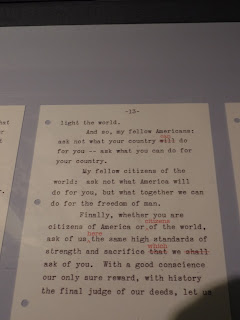For more information about
Susan Calder's books or to purchase, visit her Books We Love Author Page.
* * *
"We'll meet at The Taj, walk through The Common and have dinner at Ward 8," my nephew Ryan said.
It was almost like he was speaking another language.
In May, my husband Will and I visited Boston, Massachusetts, to attend Ryan's university graduation ceremonies. Since Will and I had only seen the city briefly around thirty years ago, we added five extra days to take in the sights.
First up on many Boston tourist agendas is the Freedom Trail, a walk past Boston locations related to the American Revolution (1775-1783). With our trail map in hand, we rambled through the Granary Burying Ground, final resting place of Boston notables like Paul Revere, Benjamin Franklin's parents and possibly Mother Goose.
 |
| Granary Burying Ground |
The map then guided us to the site of the Boston Massacre, where five men were killed in a clash between Colonists and British Troops. After Faneuil Hall, a meeting place and market since 1742, we reached Paul Revere's house and the Old North Church. We gazed up at the church steeple in which the sexton famously hung two lanterns to signal the beginning of Revere's ride that ignited the Revolution.
 |
| Old North Church, Boston's oldest church building |
Day Two took us to the John F. Kennedy Presidential Library and Museum, built on the waterfront because JFK, an avid sailor, loved the ocean.
 |
| JFK's sailboat outside of the museum |
A few days later, we would visit the house in suburban Brookline where the future president was born and lived until the family grew beyond four children. After her son died, Rose Kennedy purchased the house and had it decorated the way it was when the family lived there.
 |
| JFK's relatively modest birth home in Brookline, MA |
 |
| The small table in the Kennedy's dining room was used by Jack and his older brother Joe. |
A few steps from the JFK Presidential Library is the Edward Moore Kennedy Senate Museum. In the exact replica senate room, we debated a current senate bill: The Dairy Pride Act, which would forbid the use of the word 'milk' on labels for products not produced from hoofed animals. If this actual bill passes, good-bye soy milk.
 |
| Senator Calder in the EMK Museum |
Landscape architect Frederick Law Olmsted resided not far from the Kennedy's house in Brookline. Olmsted, who designed Central Park in New York City, Golden Gate Park in San Francisco and numerous other public and private gardens, built a home/office that is now a National Historic Site open to public tours.
 |
| Me with my sister and brother at the Olmsted home/office - Yes it sometimes rains in Boston |
Another Bostonian who showed us an aspect of her city was Isabella Stewart Gardner, art collector, philanthropist and larger than life character from the early 20th century. A visit to the art museum she founded to house her collection made my bucket list after I read the novel The Art Forger by B.S. Shapiro, a suspenseful tale about the 1990 theft of 13 works from the museum, including paintings by Rembrandt and Degas. It remains the largest unsolved art heist in history and the Gardner museum is currently offering a reward of $10 million for information leading to the works' return. Will and I were awed as much by the museum design of an Italian palazzo as we were by the art.
 |
| Gardner Museum Courtyard |
Isabella had so much clout in her day that when she moved from her home in Boston's prestigious Back Bay to live on the top floor of the museum, she convinced the city to change her old address from 152 to 150 Beacon St. so no future owners would have her number.
Works by artist John Singer Sargent feature prominently in Isabella's collection. Boston has claimed Sargent as its own even though he spent most of his life in Europe. Sargent's murals are a highlight of the magnificent Boston Public Library.
 |
| Sargent murals in Boston Public Library |
Boston also claims numerous authors, including one of my childhood favourites Louisa May Alcott. Before the American Civil War, the Alcott family lived in a house in Beacon Hill, near the apartment Will and I rented for our stay.
 |
| Louisa May Alcott home |
Another book from my childhood,
Make Way for Ducklings, written and Illustrated by Robert McCloskey, led to a fun and interactive statue in Boston Public Garden. The book about a pair of mallards who decide to raise their family in this city park is the official children's book of the Commonwealth of Massachusetts. Who knew states had official books? What a great idea.
 |
| Make way for these ducklings |
Boston Public Garden merges into Boston Common, the city's central park and, of course, The Common in my nephew's meeting instructions. The Taj turned out to be a historic luxury hotel facing the Public Garden. Ward 8 is a restaurant in the North End, former neighbourhood of Paul Revere and now inhabited by numerous Italian restaurants. We sampled some delicious local specialties - cannoli pastries and the favourite pizza of honorary Bostonians Rob Lowe and Leonardo diCaprio.
 |
| Will, Leonardo and Rob at Regina Pizzeria |
 |
| Cannoli |
Will and I loved Boston and are grateful to all of the Bostonians, past and present, who shared glimpses of their city. And we can't forget our favourite Boston resident, my nephew Ryan Calder. Congratulations Graduate.
















































.png)

.jpg)



